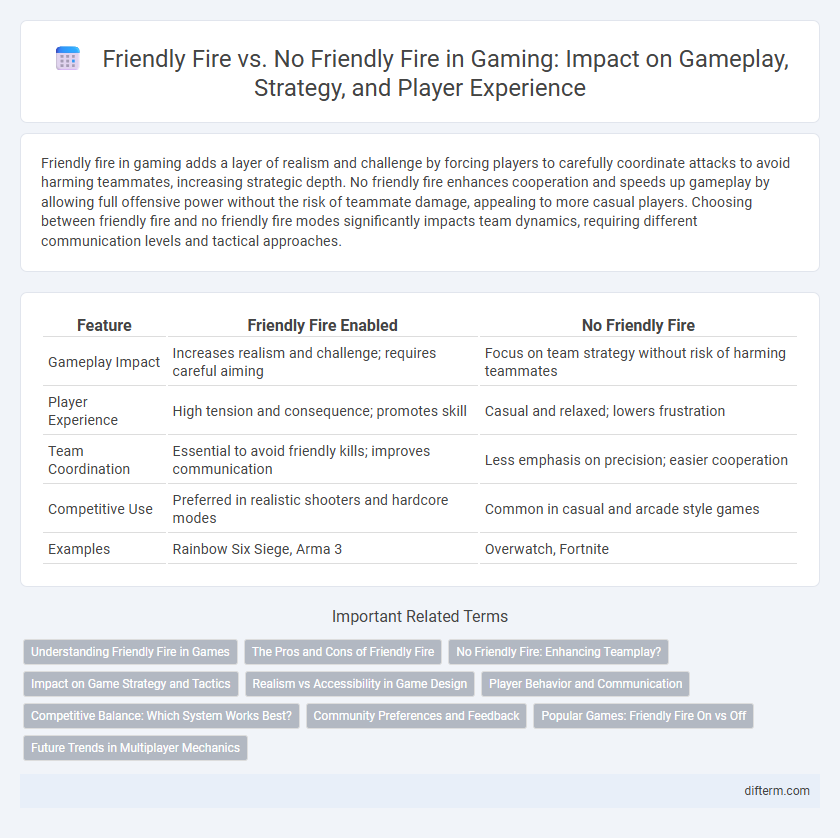Friendly fire in gaming adds a layer of realism and challenge by forcing players to carefully coordinate attacks to avoid harming teammates, increasing strategic depth. No friendly fire enhances cooperation and speeds up gameplay by allowing full offensive power without the risk of teammate damage, appealing to more casual players. Choosing between friendly fire and no friendly fire modes significantly impacts team dynamics, requiring different communication levels and tactical approaches.
Table of Comparison
| Feature | Friendly Fire Enabled | No Friendly Fire |
|---|---|---|
| Gameplay Impact | Increases realism and challenge; requires careful aiming | Focus on team strategy without risk of harming teammates |
| Player Experience | High tension and consequence; promotes skill | Casual and relaxed; lowers frustration |
| Team Coordination | Essential to avoid friendly kills; improves communication | Less emphasis on precision; easier cooperation |
| Competitive Use | Preferred in realistic shooters and hardcore modes | Common in casual and arcade style games |
| Examples | Rainbow Six Siege, Arma 3 | Overwatch, Fortnite |
Understanding Friendly Fire in Games
Friendly fire in games refers to the ability for players to inflict damage on their teammates, adding a layer of realism and strategic complexity. Enabling friendly fire encourages careful targeting and communication, while disabling it often promotes faster-paced gameplay and reduces accidental team conflicts. Understanding the impact of friendly fire settings helps players adapt their tactics and enhances overall team dynamics.
The Pros and Cons of Friendly Fire
Friendly Fire enables realistic combat scenarios by increasing tactical challenge and teamwork, but it can also lead to frustration and accidental team kills that disrupt gameplay flow. No Friendly Fire promotes a more casual and forgiving environment, ideal for novice players, yet it reduces strategic depth and the importance of communication. Balancing Friendly Fire settings is essential for tailoring gaming experiences to player skill levels and desired intensity.
No Friendly Fire: Enhancing Teamplay?
No Friendly Fire settings significantly enhance teamplay by removing the risk of accidental damage among teammates, allowing players to focus on coordinated strategies and communication. This environment fosters trust and encourages aggressive teamwork without the fear of harming allies. Game modes featuring No Friendly Fire often lead to smoother cooperation and more enjoyable multiplayer experiences.
Impact on Game Strategy and Tactics
Friendly fire settings significantly influence game strategy and tactics by altering player behavior and decision-making. Enabling friendly fire demands heightened communication, precision, and caution, encouraging players to coordinate closely and adopt defensive maneuvers to avoid accidental team damage. In contrast, disabling friendly fire allows for more aggressive tactics and risk-taking, as players can focus solely on enemy engagement without concern for harming teammates, which often results in faster-paced, less cautious gameplay.
Realism vs Accessibility in Game Design
Friendly fire in game design enhances realism by simulating the consequences of shooting teammates, requiring players to exercise caution and teamwork. No friendly fire prioritizes accessibility, reducing player frustration and making games more approachable for casual audiences. Balancing these mechanics depends on targeting immersive experiences versus broad player inclusivity.
Player Behavior and Communication
Friendly Fire influences player behavior by promoting cautious targeting and enhancing communication to avoid team damage. No Friendly Fire encourages aggressive tactics and reduces the need for precise coordination, often leading to more chaotic gameplay. Effective team communication is crucial in Friendly Fire settings to coordinate movements and prevent accidental harm.
Competitive Balance: Which System Works Best?
Friendly Fire introduces realistic consequences by requiring players to aim carefully, enhancing skill-based gameplay and strategic depth in competitive gaming. No Friendly Fire eliminates accidental teammate damage, promoting faster-paced, team-oriented dynamics and reducing frustration during high-stakes matches. Competitive balance depends on game design goals: skill emphasis favors Friendly Fire, while accessibility and cohesion benefit from No Friendly Fire systems.
Community Preferences and Feedback
Community preferences on friendly fire versus no friendly fire in gaming reveal a strong divide based on gameplay style and competitive intensity. Many players favor no friendly fire to promote teamwork and reduce frustration, while others prefer friendly fire enabled to enhance realism and strategic depth. Feedback often highlights that customizable settings allow communities to tailor experiences, balancing fairness with challenge according to player demand.
Popular Games: Friendly Fire On vs Off
Popular games like Call of Duty and Battlefield offer Friendly Fire On settings that enhance realism and strategic teamwork by requiring players to avoid harming allies. In contrast, games such as Fortnite and Apex Legends often have Friendly Fire Off, promoting fast-paced, aggressive gameplay without the risk of accidental team damage. Player preference for Friendly Fire On or Off significantly impacts game dynamics, fostering either cautious cooperation or relentless action.
Future Trends in Multiplayer Mechanics
Future trends in multiplayer gaming indicate a shift towards customizable friendly fire settings, allowing players to tailor their experience for increased realism or casual play. Advanced AI and machine learning are being integrated to balance friendly fire consequences, enhancing strategic depth without frustrating players. This evolution promotes more dynamic team interactions, fostering both competitive and cooperative gameplay in diverse multiplayer environments.
Friendly Fire vs No Friendly Fire Infographic

 difterm.com
difterm.com